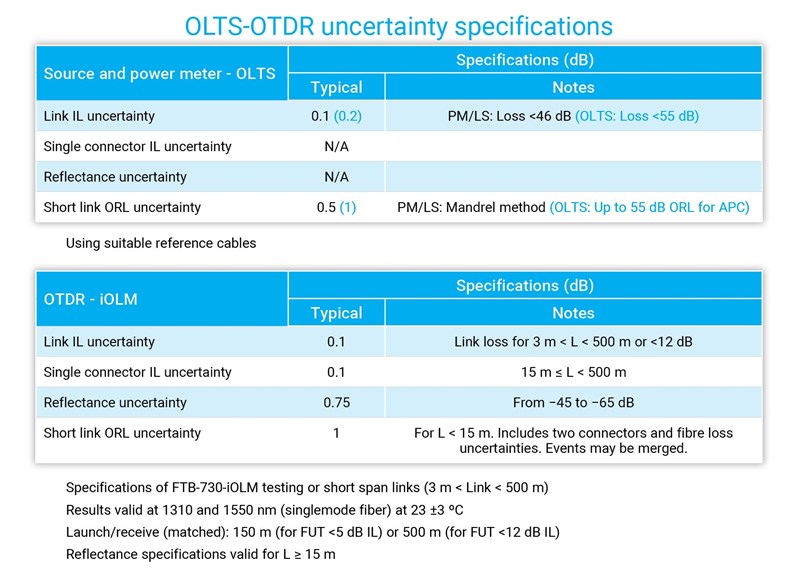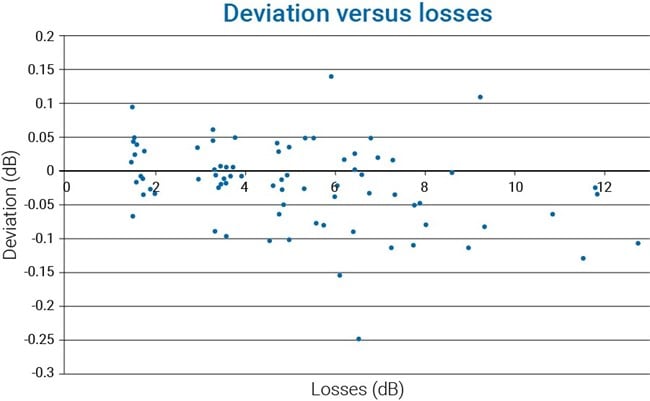When to use an OTDR vs light source power meters
The ongoing data center and enterprise network challenge to rapidly migrate to 40 and 100G transmission speeds (with 200 and 400G on the horizon) coupled with ongoing changes in connectivity—such as parallel optics, PAM4, and OM5 wide band multimode fiber with short wavelength division multiplexing (SWDM)— requires less tolerance for errors and much tighter loss budgets. These ever-increasing transmission speeds in conjunction with more complex connectivity heighten the probability that connection reflectance could lead to network failure. Consequently, accurate and comprehensive testing and measurement is more crucial today than ever before.
As experts in the R&D and manufacturing of advanced test equipment, EXFO contends that an optical time domain reflectometer (OTDR) is the best choice of equipment with which to conduct complete and comprehensive testing and measurement of today’s evolving networks. Unlike the less capable, but still valuable, optical loss test set (OLTS) and light source power meter (LSPM), an Encircled Flux (EF) compliant OTDR measures localized insertion loss and reflectance for each connector on the fiber link and precisely detects the position of the fault for all input and output connectivity. The OTDR also provides information for total optical return loss (ORL), link loss, and the length of the fiber link. Conversely, the OLTS cannot evaluate or measure crucial reflectance (see Figure 1 below) and it cannot detect the source of a problem or the location of fault(s).
Why isn’t the OTDR being used to its full potential?
So why isn’t the more comprehensive OTDR being used at its full potential for verification and validation tests of the fiber optic infrastructure? Currently, standard bodies, including TIA and its ANSI/TIA-568.3-D standard, mandate the OLTS as the testing solution for Tier 1 fiber characterization tests and the OTDR for Tier-2 troubleshooting tests.
EXFO supports its position that the OTDR should be considered for Tier 1 status, based on three primary propositions:
- Poor reflectance of connectors is the primary enemy of flawless performance for speeds higher than 10 Gbit/s (at 25 or 50 Gbit/s lane rate, for 100-200-400 Gbit/s interface)
- The OTDR is the only technology with the ability to assess and position reflectance on a data center fiber optic network
- In the field, comparable uncertainty of the link loss measurement around ±0.2-0.25 dB can be achieved for both technologies
While the OLTS and LSPM have been used adequately for years in networks running at speeds up to 10 Gbit/s, assumptions and misconceptions circulate within the data center and fiber optic test industries that the OTDR yields more uncertainty in link loss measurements when compared to OLTS and LSPM. This is simply not accurate. In fact, comparable uncertainty of the link loss measurement around ±0.2 to 0.25 dB can be achieved for both technologies when:
- Uncertainty contributors for both are understood and when actions are made to reduce those uncertainties
- Best practice parameters for each technology are followed using state-of-the art solutions
As a leading manufacturer of a myriad of test solutions, including OLTS, LSPMs, and OTDRs, our position advocating the OTDR as a Tier 1 test solution and dispelling misconceptions about the OTDR is totally unbiased and based on objective and in-depth studies.

Figure 1. OLTS and OTDR uncertainty specifications
Understanding uncertainty contributors
LSPM loss measurement uncertainty has been studied in depth by the International Electrotechnical Commission (IEC) subcommittee 86C and a technical report was produced on the topic (IEC TR 61282-14(2015)). The report provides an extensive review of all contributors to measurement uncertainty along with details for one-, two-, and three-cord configurations. The report’s table of contents categorizes the uncertainties of the LSPM by environment, operator skills, measurement methods, measuring instruments, setup and cabling.
As an example, a typical total uncertainty or deviation value for a multimode loss measurement using a one-cord reference at 850 nm for a link of 300 m with a total loss of 1.6 dB has been calculated at ±0.27 dB. This is higher than most technicians or installers would have expected. This is because the uncertainty is originating from the test instruments and from the mating to and from the device under test (DUT) due to its spectral dependency.
Our studies at EXFO for OLTS/LSPM include both theoretical and real-life uncertainty contributors. Some real-life uncertainties include:
- Source drift after referencing
- Reference test jumpers quality and condition
- OLTS LSPM coupled through a fiber coupler, with which the coupler itself, induces some additional uncertainties due to coupler polarization that adds to the total uncertainty
Other OLTS/LSPM measurement uncertainties can include dirty connectors, worn test cords, non-linearity of the power meter, fiber manipulations, and launch conditions. Some of these uncertainties can affect an OTDR’s performance, as well.
For the OTDR, however, it is difficult to predict the loss measurement uncertainty based on its specification sheet. Unlike the LSPM, OTDR loss measurement uncertainty cannot be derived from typical uncertainty contributors since too much variability exists between OTDR models and manufacturers. Moreover, uncertainty also depends on the nature of the link under test (length, loss and reflectance). Accordingly, it is recommended that OTDR uncertainty be carefully evaluated for a given OTDR model, under specific test conditions and for a given set of link parameters.
EXFO takes extra care in developing advanced OTDRs with iOLM (intelligent Optical Link Mapper) software that address and minimize measurement uncertainties. For example, EXFO’s EF compliant FTB-720C QUAD iOLM OTDR specifies tighter fiber geometry tolerances for the test cords (SPSB), thereby minimizing errors due to fiber geometry.
Best practice parameters for comparable ±0.2-0.25 dB link loss measurement
A trend that we witness is that many larger data centers and enterprises are deploying singlemode fiber only, largely due to the drop of singlemode transceiver prices. These larger networks can have potentially thousands of various connectors within their infrastructure. The OLTS does provide a faster test time for link loss measurement at two wavelengths, typically 3 seconds per pair of fiber (duplex) or 5 seconds per fiber (simplex) when optical return loss (ORL) is combined with the link loss measurement (singlemode test only). On the other hand, the OTDR requires a test time of 10-15 seconds per fiber with a wavelength for fiber distance of less than 2 km, which is a representative scenario for data center networks.
It is worth reiterating again that only the OTDR technology is capable of measuring crucial connector reflectance and to locate those that are faulty to minimize the threat of network downtime or failure.
In order to achieve comparable uncertainty of the link loss measurement of ±0.2-0.25 dB for both OLTS/LSPM and OTDR technologies, the following best practices should be followed:
For OLTS/LSPMs
- Use a properly constructed one-cord reference test method
- Make sure to adhere to the manufacturer’s recommended recalibration schedule
- Use very good reference-grade test cords with good quality connectors that are changed at 200 matings
For OTDRs
- Use the same fiber type, manufacturer, and model for both launch and receive test cords
- To avoid uncertainties related to the connectors’ mating loss reproducibility, it is strongly recommended to use unused, new reference-grade launch and receive test cords
- In the case of SMF measurement, a launch test cord of at least 15 meters must be used
- For MMF measurement, the launch set-up must also ensure EF conditioning
- To reduce measurement uncertainty related to fiber geometry during an EXFO-iOLM test, it is important to use the same fiber type, and the same manufacturer and model for launch and receive test cords
- Use very good reference-grade test cords with good quality connectors that are changed at each 200 matings
- Make sure to adhere to the manufacturer’s recommended recalibration schedule
Conclusion
EXFO has performed measurements and has published results demonstrating that an iOLM OTDR can measure insertion loss that is very close to a reference measurement, with a deviation that is below 0.25 dB for both multimode and singlemode fiber use cases.

Figure 2. iOLM-OTDR SMF deviations vs. losses
We have demonstrated comparable performance beween the OTDR (using the iOLM software) and the LSPM setup for the measurement of end-to-end insertion loss measurement. For multimode fiber, a small non-concerning bias was found between the OTDR and the LSPM due to the OTDR backscattering process. For singlemode fiber, as depicted in Figure 2, there is no systematic bias between the OTDR and the LSPM.
Based on these results, it is clear that the OTDR should be considered a valid candidate for Tier 1 fiber characterization tests, especially due to the OTDR’s exlusive capability to measure reflectance—a crucial advantage minimizing downtime and network failure for the quickly expanding number of data center and fiber networks running at greater than 10 G/bits.
For more information and the in-depth full version of this discussion, please download Application Note 342: Link Loss Measurement Uncertainties: OTDR vs. Light Source Power Meter.




